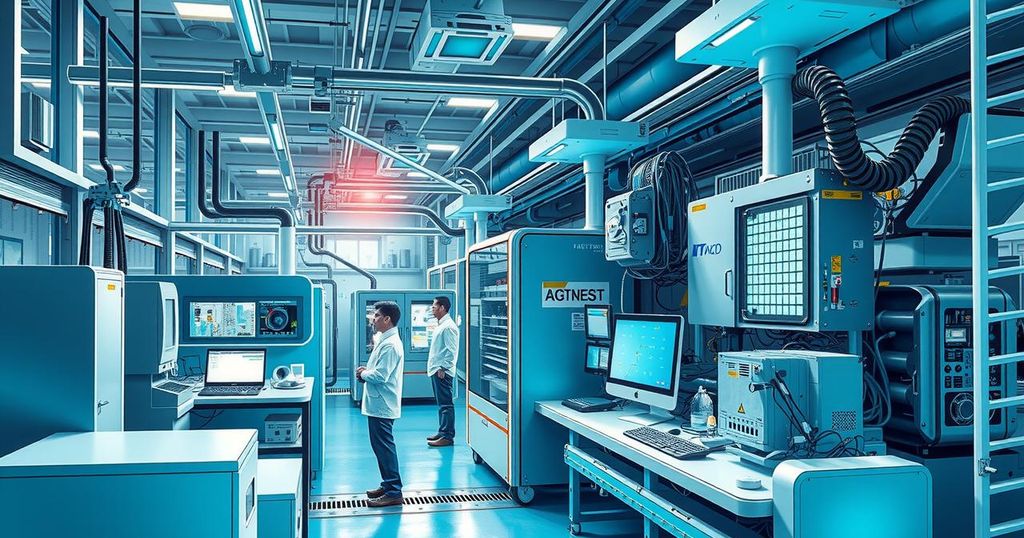Malaysia’s Ambitious $107 Billion Semiconductor Initiative: The National Semiconductor Strategy

Malaysia is investing aggressively in the semiconductor industry through its National Semiconductor Strategy, launched in May 2024, aiming to attract MYR500 billion in investments. This strategy seeks to upskill 60,000 engineers and create homegrown tech companies while enhancing sustainability. The government’s focus on collaboration and leveraging its geopolitical neutrality positions it favorably amidst rising global competition in the semiconductor market.
Malaysia is positioning itself as a key player in the global semiconductor industry, launching the National Semiconductor Strategy (NSS) under Prime Minister Anwar Ibrahim in May 2024. The goal? To attract upwards of MYR500 billion (approximately $107 billion) in investments, both public and private, to bolster the nation’s chip capabilities, according to Reuters. This marks a significant shift in Malaysia’s approach to semiconductors.
Historically, Malaysia has operated mainly in back-end processes like assembly and packaging for semiconductor firms such as Intel and Infineon, which have thrived in the country due to its reliable infrastructure and skilled workforce. However, with this new strategy, Malaysia aims to climb the value chain, focusing on chip design, advanced packaging, and research and development. This move aligns with global technology trends, as countries scramble to secure their semiconductor supply chains amid rising geopolitical tensions, especially between the US and China. As pointed out by The Diplomat in early 2025, Malaysia’s neutral stance in these relations could give it a distinct advantage.
A key element of the NSS is an enticing fiscal framework aimed at attracting foreign investors and encouraging local businesses. The Malaysian government has committed MYR25 billion (roughly $5.3 billion) in various incentives such as tax breaks, grants, and support for land and infrastructure, as reported by Free Malaysia Today. Simultaneously, the Malaysian Investment Development Authority (MIDA) actively seeks out major semiconductor companies from the US, Europe, and Japan. Intel and Infineon’s recent financial commitments to expand operations in Malaysia signal early success for the NSS.
Recognizing the critical shortage of skilled labor in semiconductor manufacturing, Malaysia’s strategy includes plans to train and upskill around 60,000 local engineers. This entails new educational partnerships and technical certification programs aimed at bridging the talent gap. The Ministry of Higher Education has also proposed “dual-training systems,” combining classroom instruction with practical factory experiences. KR Asia reports that these initiatives will not only address current staffing shortages but will also help retain top engineers by offering competitive salaries.
As the NSS aims to nurture homegrown companies in advanced technologies, it seeks to create at least ten local firms specializing in advanced packaging and integrated circuit design. Each of these startups is projected to generate between MYR1 billion and MYR4.7 billion ($210 million to $1 billion) by 2030. Khazanah Nasional, the national investment fund, and other government-linked investors are expected to back these local ventures. Furthermore, there is a strong emphasis on commercializing university research in semiconductor-related fields, as noted by Digital News Asia.
Malaysia’s prime geographical location, coupled with its political neutrality, makes it a strategic hub for semiconductor manufacturers. The country’s strong infrastructure and competitive electricity rates, especially in key locations like Penang, Johor, and Sabah, are vital for an industry that depends heavily on timely production and logistics. Moreover, Malaysia’s active participation in ASEAN and various trade agreements boosts its profile as a semiconductor hub, alongside its logistics capabilities.
The NSS also advocates for a collaborative rather than competitive strategy, focusing on partnership opportunities instead of direct confrontations with semiconductor powerhouses like Taiwan or South Korea. Initiatives for cross-border research and development are underway, inviting foreign partners to invest in innovation parks and pilot production lines. As reported by Free Malaysia Today, these collaborative efforts extend to nations like Japan, Vietnam, and Singapore, enhancing regional semiconductor supply chains.
Furthermore, the strategy aligns well with the global emphasis on sustainability. Malaysia is pushing for eco-friendly manufacturing practices and renewable energy use within the semiconductor sector, according to TIME. As tech firms continue to prioritize ESG considerations, Malaysia’s commitment positions it favorably as a future-focused production site.
The road forward will undoubtedly be challenging, as Malaysia must contend with established semiconductor players and emerging competitors such as India and Vietnam. But the NSS’s structured plan and the government’s commitment to talent development and innovation could well determine Malaysia’s destiny in the semiconductor race. By heavily investing in this sector, Malaysia is not just enhancing its industrial capabilities but also aiming for long-term technological independence. As the global demand for semiconductors surges, Malaysia is clearly indicating it is in it for the long haul—”playing for keeps,” as many might put it.
Malaysia’s aggressive strategy to position itself within the global semiconductor supply chain is both ambitious and extensive. The NSS seeks to attract substantial investment, train a future-ready workforce, and create homegrown companies in advanced technology fields. With a focus on collaboration, sustainability, and leveraging its geographic advantages, Malaysia aims to not only elevate its semiconductor industry but also secure its technological sovereignty as geopolitical competition intensifies. However, only time will tell if the anticipated results will match the strategic vision.
Original Source: www.intellinews.com




